Woodworkers rely on the lathe for a variety of projects in the workshop. From ornately designed table legs to decorative wooden fruit bowls, these handy machines turn pieces of wood so that you can achieve a uniform design around its entire circumference.
While the best wood lathe can cost you thousands of dollars, there are plenty of more affordable options that the weekend do-it-yourselfer or entry-level craftsman can add to the shop.
Wondering what models will perform well without breaking the bank?
Before you spend your money, refer to our useful buying guide where you can easily compare the top ten lathes and learn more about what to look for as you shop for one.
Top 10 Wood Lathes Comparison Table
| Picture | Name | Type | Price | Rating (1-5) |
|---|---|---|---|---|
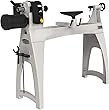 | 1. Jet JWL-1640EVS 16"x40" Wood Lathe | Freestanding | $$$$ | 4.6 |
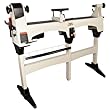 | 2. JET JWL-1221VS 12-Inch by 21-Inch Variable Speed Wood Lathe | Freestanding | $$$ | 4.5 |
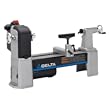 | 3. Delta Industrial 46-460 12-1/2-Inch Variable-Speed Midi Lathe | Bench Top | $$$ | 4.5 |
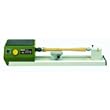 | 4. Proxxon 37020 DB 250 MICRO Woodturning Lathe | Bench Top | $$ | 4.2 |
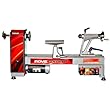 | 5. NOVA 46300 Comet II Variable Speed Mini Lathe 12-Inch x 16 1/2-Inch | Bench Top | $$$ | 4.6 |
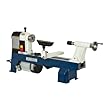 | 6. RIKON 70-100 12-by-16-Inch Mini Lathe | Bench Top | $$ | 4.1 |
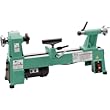 | 7. Grizzly H8259 Bench-Top Wood Lathe, 10-Inch | Bench Top | $$ | 4.1 |
 | 8. WEN 3421 3.2-Amp 8" by 12" Variable Speed Mini Benchtop Wood Lathe | Bench Top | $ | 4.4 |
 | 9. SHOP FOX W1704 1/3-Horsepower Benchtop Lathe | Bench Top | $$ | 4.2 |
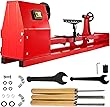 | 10. Mophorn 14" x 40" Power Wood Turning Lathe | Bench Top | $$ | 3.7 |
Things to Consider Before Buying a Wood Lathe
- Size: Is it a full, mid or small wood lathe?
- Weight: Does it sit firmly or is it unbalanced?
- Materials: Is it made of cast iron or stainless steel?
- Motor: Does it have enough power for your projects?
- Variable Speed: Can you adjust the speed without stopping the lathe?
Freestanding vs. Bench Top
When it comes to deciding whether to purchase a freestanding lathe or a benchtop lathe, you’ll need to keep a few things in mind.
- How Much Space You Have. Since benchtop models are much smaller, it is easier to incorporate them into a workshop no matter how much space you have.
Freestanding lathes take up more floor space, so make sure you have enough room in your shop before purchasing one.
Mini lathes are great if you want a portable unit, which would be handy at a fair or a craft show when you want to give live demonstrations to the crowd.
- The Size of Your Projects. Small lathes can handle spindles that you would use on a chair back, rolling pins, candle holders, or any other small craft projects, but they aren’t going to be long enough for pieces such as table legs and stair spindles.
Those of you interested in turning wide pieces of wood to make bowls should check to see what the maximum bowl diameter is (also known as the swing capacity) for the particular lathe that you like.
Does It Come with a Warranty?
When you are spending this much money on a power tool, you should expect some kind of warranty from the manufacturer.
The Nova 1624 II, which we will be looking at in our “Review” section, comes with a 5-year limited warranty while the Delta Industrial 46-460 Midi Lathe offers a regular 5-year warranty.
Regardless of what they offer, you should always do some research to see how good a brand’s customer service is; even those who offer a good warranty might be incredibly slow to respond should you encounter any problems.
Top 3 Best Wood Lathe Reviews
The best wood lathe varies from user to user, but these three models are well-known for their performance, quality, and warranty.
If you’re looking for something smaller, be sure to check out the other benchtop lathes we included in our list and compare them to see which will meet your project needs.
1. Jet JWL-1640EVS 16″x40″ Wood Lathe

Jet JWL-1640EVS freestanding lathe runs smoothly and extremely quiet. It features a 1.5 horsepower DC motor that runs on 120v and offers you different variable speed settings from as low as 40 RPM up to a speedy 3,200 RPM.
The lathe is extremely well built with heavy, solid construction. The motor is reversible and has variable speeds on both directions.
Assembly is quick and easy and we found it to be an excellent entry-level unit for those who have serious woodworking intentions.
Jet offers a full replacement 5-year warranty on all parts of the lathe. They are known for providing good customer service, so we wouldn’t expect you to encounter any problems should you need to contact them.
It is one of the most expensive lathes on the list simply because it is a freestanding model, but if you prefer to spend a bit less or need a smaller lathe, check out the next two options.
2. JET JWL-1221VS Variable Speed Wood Lathe

This model from Jet is also freestanding and offers users more precise speed control than the Nova, turning as low as 60 RPM and as fast as 3,000 RPM. The motor is slightly less powerful on this model at just 1 horsepower, but the features and capabilities are much more than you would expect for a lathe in this price range.
The indexing head can be set to 24 different positions and it has the reverse option just like the Nova.
The level of quality is superb, as is the level of control on this machine. It feels very natural to use and everything is distanced perfectly to make it comfortable as you shape your wood.
The 5-year warranty is quite impressive, and they have service centers across the U.S. Contact them Monday-Friday for assistance or questions. Great company and great product!
3. Delta Industrial Variable-Speed Midi Lathe

Delta is probably one of the most popular products on our list, and while it doesn’t quite perform at the same level as the Nova or the Jet, it is still an excellent product.
It features a 1 horsepower motor with a variable speed range and a 12 ½-inch swing capacity. It is quite balanced since they added extra weight on the bed and base to help prevent it from vibrating on the higher speed settings.
The belt discs feature six grooves instead of three or four, which helps prevent the belt from slipping as it turns and therefore results in fewer stalls as you work on thicker, denser material.
As-is, this lathe is a benchtop model, but you can purchase the stand separately, which will increase the price a bit.
Here you can see a Delta’s demo of the product so you can see how it works and a highlight of the features.
Frequently Asked Questions
How Do You Use a Wood Lathe?
Before you use your wood lathe, you must ensure that the cutting tools are sharp. Use standard sharpening techniques on a high-speed grinder to remove the turning marks from various shaped carbide tooling and re-shape the cutting edges as needed.
If you have never used a lathe before, you’ll need to start by securing the wood stock in the wood lathe. You can do this by tightening the chuck jaws around the stock until there is no longer any space between the stock and the machine.
When working with small pieces of stock, you may find it easier to tape them in place with masking tape or another strong tape. Once the wood stock has been secured and positioned, it is time to turn on the lathe. Twist the speed dial to turn on the lathe.
The speed dial is typically located near your hand close to the shaft of the wood lathe. Depress the foot pedal with your foot to engage the gears that will start turning. This is when you must be careful as things can quickly go south or, in this case, north.
What Can You Make on a Wood Lathe?
Wood lathes are fantastic tools for making a wide array of wooden objects. Whether you’re an artist who needs a professional-quality lathe, or just looking for a hobby to add to your evenings, wood lathes are the way to go.
Wood lathes are enormously diverse machines, capable of carving or shaping a large variety of objects. There are any number of projects that can be taken on as a wood lathe; from small pieces like decorative pen holders and necklaces for mom to large furniture pieces.
Are Wood Lathes Dangerous?
Wood lathes are dangerous to operate. Woodturners can use a lathe to shape wood using a sharp tool. They can also use a lathe for many other woodworking projects like bowls, spindles, and chess pieces.
These tools are dangerous because the wood can spin at speeds up to 4,000rpm while a sharp lathe tool is used to shape it.
Woodturning and wood lathes are dangerous when used improperly or by children, since bodily accidents can result from lack of appropriate safety precautions and from the use of sharp machines.
How Fast Should a Wood Lathe Turn?
When a lathe is being used to create a piece of wood or even metal, the general rule is that the stock should be turned at least three times faster than the actual length of the stock.
For example, if you are working with ½” thick material, then it’s best to turn it at a rate no less than 1/8th of an inch per second.
To put this into a practical perspective, turning wood at a speed of 500 RPM is not going to make a clock run any faster when used as a pendulum.
The same can be said for making pens or turning the one-inch diameter shafts on wooden valve stems. They all require very low speeds because the “cutting” is all about surface friction vs. momentum.
Why Does My Wood Lathe Chatter?
Chatter can be described as a buzzing sound, and is caused by your wood lathe when cutting to the extreme or being smaller than the maximum recommended diameter.
The cause of this can be hard to find and identify, but once you have found the root cause, it can make all the difference in determining what type of projects can be created.
Chatter is caused by the workpiece flexing which changes the angle between the cutter and its path on the workpiece. This causes your tools to change cutting directions and not cut smoothly.
Chatter is what happens when the wood lathe starts to spin the workpiece, and the pressure put on the tool from the wood causes it to bend back and forth at a high rate of speed.
It looks similar to a saw blade chattering through a board. This not only makes it difficult for you to control your cuts but can also lead to the wood piece possibly flying out of your hands or falling off of your lathe completely.
How Do You Fix a Vibration on a Wood Lathe?
When you are first learning how to turn a bowl on the wood lathe, you’ll notice that as you gradually slow down the lathe speed that there is a point where the bowl starts to vibrate very quickly. There are three things that can happen at this point.
The first thing is the bowl centers and keeps turning without vibration. The second is that the bowl will start to chatter and bounce around on the ways.
This is not good either but it’s better than seeing your work break apart in pieces under the turning force of your chisel. The third thing that can happen at this point is that nothing much happens at all when slowing down.
Vibration on a wood lathe is caused by a cut that is too deep for the diameter of the tool to rest at that location, or possibly a rough spot on the wood.
Vibration can also be caused by cutters striking something on the edge of the bowl blank (this side-to-side whipping action), or cutting slightly too fast.
A vibrating cut usually occurs because the tool rest is holding the cutter too high for the diameter of the blade at that location, or because the wood surface is rough or has a slight depression where you are cutting.
This causes the blade to whip from side to side as it enters and exits the wood. Cut slightly slower and be sure your tool rest is holding the cutter low enough for cutting at that spot.




